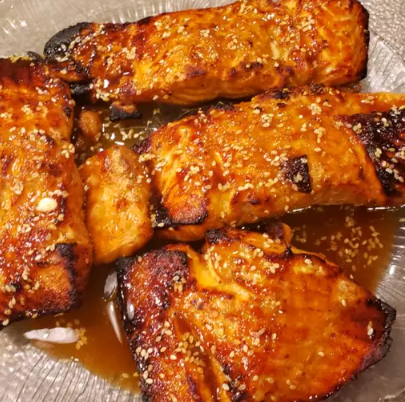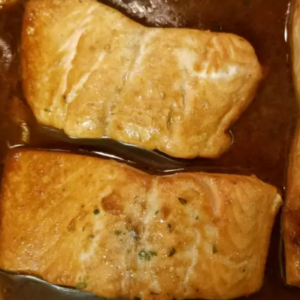Uses and Recipes
Culinary Uses of Teriyaki Sauce
What is teriyaki made of? Teriyaki sauce is not just for traditional Japanese dishes; its versatility makes it an indispensable ingredient in kitchens around the world. Whether used as a marinade, glaze, or finishing sauce, teriyaki adds a rich, umami-packed punch that elevates any meal.
Teriyaki sauce is particularly popular for marinating proteins such as chicken, beef, and fish, where it imparts a deep, savory flavor that complements the natural taste of the meat. Vegetarians also revel in teriyaki’s ability to transform tofu and vegetables into vibrant, flavorful dishes. Beyond marinating, it serves wonderfully as a glaze for grilled or broiled dishes, adding a shiny, appetizing finish that is visually appealing and delicious.
Popular Teriyaki Recipes
From quick weeknight dinners to elaborate gatherings, teriyaki recipes offer a range of options for any occasion. Below are some beloved recipes that showcase the adaptability and appeal of teriyaki sauce.
Teriyaki Chicken
One of the most beloved dishes, teriyaki chicken, is a testament to the sauce’s ability to make simple ingredients stand out. Start by marinating chicken pieces in teriyaki sauce for at least 30 minutes, or overnight for deeper flavor. Cook the chicken in a skillet or grill until golden and cooked through, basting with extra sauce for that classic teriyaki glaze. Serve with steamed rice and vegetables for a satisfying meal.
Teriyaki Beef Stir-Fry
For a quick and hearty meal, teriyaki beef stir-fry hits all the right notes. Thinly slice beef and marinate it in teriyaki sauce. In a hot wok or skillet, stir-fry the beef with a mix of colorful vegetables like bell peppers and broccoli. The high heat caramelizes the sauce, coating the ingredients in a sticky, sweet glaze. Serve over a bed of fluffy rice or noodles for a complete dish that packs a flavorful punch.
Health Benefits and Dietary Considerations
Nutritional Profile of Teriyaki Sauce
While teriyaki sauce adds a burst of flavor to dishes, it’s also worth considering its nutritional aspects. Typically, teriyaki sauce contains soy sauce, which is rich in amino acids, the building blocks of protein. Mirin, another key ingredient, while sweet, can offer trace amounts of minerals and vitamins. Understanding the health impacts of these ingredients can help you make informed dietary choices.
Benefits of Ingredients
The ingredients in teriyaki sauce, such as soy sauce, are known for their health benefits. Soy sauce is a good source of antioxidants and has been linked to heart health due to its isoflavones. Mirin, although used in small amounts, contains small concentrations of essential nutrients which contribute to overall health.
Dietary Considerations
For those monitoring their sodium intake, it’s important to note that teriyaki sauce can be high in salt due to its soy sauce content. However, low-sodium versions of soy sauce are available for those who want to enjoy teriyaki flavor with less salt. Additionally, for those avoiding refined sugars or adhering to a gluten-free diet, modifications to the traditional teriyaki recipe—such as using gluten-free soy sauce or natural sweeteners—can be made to accommodate these needs.
Incorporating Teriyaki into a Balanced Diet
Teriyaki sauce can be part of a balanced diet when used in moderation. It pairs well with a variety of healthy dishes, promoting a diet that’s both flavorful and beneficial.
Healthy Recipe Ideas
Explore recipes that combine teriyaki sauce with whole grains, lean proteins, and a bounty of vegetables. For instance, a teriyaki quinoa bowl with grilled veggies and chicken provides a balanced meal with a rich flavor profile.
Tips for Healthy Cooking with Teriyaki
To maximize the health benefits while minimizing any dietary drawbacks, consider using homemade teriyaki sauce with controlled amounts of natural sweeteners and low-sodium soy sauce. This approach allows you to enjoy the full flavor of teriyaki while keeping your dietary goals in check.
By exploring the nutritional aspects and offering ways to integrate teriyaki into a healthy diet, this section can provide valuable insights for those looking to enjoy this delicious sauce without compromising their health objectives.
The Cultural Significance of Teriyaki in Japan and Beyond
Teriyaki’s Role in Japanese Culinary Traditions
Teriyaki is more than just a cooking technique in Japan; it represents a significant aspect of the culinary philosophy that emphasizes balance and harmony in food. This section could explore how teriyaki fits into the broader spectrum of Japanese cuisine, including its use in special occasions and its symbolic meanings.
Historical Context and Evolution
Delve into the historical development of teriyaki within Japanese cuisine, tracing its origins from a simple method for seasoning and cooking to its status as an internationally recognized dish. Discuss how teriyaki reflects the Japanese aesthetic of simplicity and elegance in cooking.
Teriyaki in Modern Japanese Dining
Examine the presence and popularity of teriyaki in contemporary Japan. Include insights on how traditional recipes have been preserved or adapted in modern Japanese restaurants and households.
Global Influence and Adaptations of Teriyaki
As teriyaki sauce has traveled across the world, it has been embraced and adapted by various cultures, integrating into local culinary scenes and creating new fusion dishes. This section would look at the globalization of teriyaki and its cultural implications.
Teriyaki in American Cuisine
Focus on how teriyaki was introduced to the United States and its rise to popularity, particularly in how it has been adapted for American tastes and incorporated into various fast food and gourmet dishes.
Fusion Dishes and Innovations
Highlight innovative dishes that blend teriyaki with other culinary traditions, showcasing the versatility and universal appeal of this sauce. Examples might include teriyaki tacos, teriyaki-glazed salmon burgers, or even teriyaki pizza, illustrating how teriyaki has been creatively reimagined around the world.
This part of the article would enrich the narrative by providing a broader cultural perspective on teriyaki, emphasizing its impact on both traditional and contemporary gastronomy across the globe.
Internal Linking Opportunities for Enhancing the Teriyaki Article
- Link: Teriyaki Salmon
- Embed in Phrase: « teriyaki-glazed salmon burgers »
- Context: In the section discussing global adaptations of teriyaki, you mention various dishes including « teriyaki-glazed salmon burgers. » This phrase could be linked to the recipe page for Teriyaki Salmon, providing readers with a practical example of teriyaki’s application in cooking.
- Link: Teriyaki Salmon Bowl
- Embed in Phrase: « teriyaki sauce has traveled across the world »
- Context: In discussing the global influence of teriyaki, this phrase could be linked to a specific recipe that showcases a modern adaptation, such as the Teriyaki Salmon Bowl, reinforcing the culinary creativity inspired by traditional teriyaki sauce.
- Link: What is the Meaning of Teriyaki?
- Embed in Phrase: « What is Teriyaki? »
- Context: In the introductory section where you define teriyaki, linking to a detailed explanation of the term’s meaning could provide readers with additional context and deepen their understanding of the cultural and historical significance of teriyaki.
External Resources for Further Exploration on Teriyaki
- Link: What does teriyaki sauce taste like? – Quora
- Embed in Phrase: « teriyaki sauce’s rich flavor »
- Context: In discussing the ingredients and flavor profile of teriyaki sauce, this link can provide readers with a broad range of personal insights and descriptions of what teriyaki sauce tastes like, enhancing their understanding of its unique flavor.
- Link: Teriyaki Sauce – Closet Cooking
- Embed in Phrase: « cooking techniques that involve teriyaki »
- Context: This link discusses the method of cooking known as teriyaki, including its application and variations. Embedding this link when mentioning cooking techniques can provide readers with a deeper understanding of how teriyaki is traditionally used in culinary practices.
- Link: Homemade Teriyaki Sauce – The Recipe Critic
- Embed in Phrase: « homemade teriyaki sauce »
- Context:This link focuses on making homemade teriyaki sauce. It shows how easy and beneficial it can be. Embedding this link offers practical tips. It encourages readers to try their own versions. This highlights the customization of homemade sauces.
Frequently Asked Questions
What is teriyaki made of? Teriyaki is a traditional Japanese sauce that combines several key ingredients to create its unique flavor. The primary components include:
- Soy Sauce: This provides the salty base of the sauce.
- Mirin: A sweet rice wine that adds a mild sweetness.
- Sugar: Often added to enhance the sweetness, balancing the saltiness of the soy sauce.
- Sake: Some recipes include sake, which introduces a slight bitterness and complexity.
What are the essential ingredients in teriyaki sauce?
The core ingredients of traditional teriyaki sauce include soy sauce, mirin, and sugar. These components combine to create the rich, glossy sauce known for its sweet and savory flavor profile. In adaptations, ingredients like honey, garlic, and sometimes ginger are added for extra layers of taste.
Can teriyaki sauce be made without sugar?
Yes, it’s possible to make teriyaki sauce without sugar by substituting other sweeteners. Honey or agave syrup are popular alternatives that provide natural sweetness while maintaining the sauce’s characteristic glaze.
How long can you store homemade teriyaki sauce in the refrigerator?
Homemade teriyaki sauce lasts up to a week in the fridge. Store it in an airtight container. For longer storage, freeze it for up to three months. Enjoy it anytime!
These FAQs enhance your understanding of teriyaki. They encourage exploring its versatile use in cooking.



